Non-Equilibrium Crystallization of Monotectic Zn-25%Bi Alloy under 600 g
Abstract
:1. Introduction
1.1. Investigations of the Zn–Bi Alloys
1.2. Zn–Bi System Characteristic
2. Materials and Methods
3. Results
3.1. Microstructures Analysis
3.2. Crystallographic and Texture Analysis
4. Conclusions
- Gravity force strongly affects the nucleation and growth kinetics of eutectics;
- The boundary between the zinc-rich (Zn) and bismuth-rich (Bi) zones obtained for crystallization under supergravity is flat, while in the case of equilibrium crystallization, it is paraboloidal according to the curvature of the crystallization front;
- Crystallization under supergravity conditions results in high crystallographic order of the structure at both micro- and macro-scale;
- The (Zn)/(Bi) interface is formed by two structures in a specific crystallographic relationship;
- The strong gradient of the chemical composition near the separation boundary was observed;
- The microhardness of the zinc-rich area was about 58.5 HV and in the bismuth-rich area, it was decreased to 17.6 HV;
- The zinc-rich zone contained minor precipitates of parent bismuth, resulting from the mutual Bi–Zn solubility in a non-equilibrium state;
- The twins relation dominates in (Zn) crystallized under supergravity.
Author Contributions
Funding
Institutional Review Board Statement
Informed Consent Statement
Data Availability Statement
Conflicts of Interest
References
- Rogers, J.R.; Davis, R.H. Modeling of collision and coalescence of droplets during microgravity processing of Zn-Bi immiscible alloys. Metall. Trans. A 1990, 21, 59–68. [Google Scholar] [CrossRef]
- Wang, J.; Zhong, Y.B.; Fautrelle, Y.; Zheng, T.X.; Li, F.; Ren, Z.M.; Debray, F. Influence of the static high magnetic field on the liquid–liquid phase separation during solidifying the hyper-monotectic alloys. Appl. Phys. A 2013, 112, 1027–1031. [Google Scholar] [CrossRef]
- Löffler, J.F.; Johnson, W.L. Crystallization of Mg–Al and Al-based metallic liquids under ultra-high gravity. Intermetallic 2002, 10, 1167–1175. [Google Scholar] [CrossRef]
- Löffler, J.F.; Bossuyt, S.; Peker, A.; Johnson, W.L. Eutectic isolation in Mg-Al-Cu-Li(-Y) alloys by centrifugal processing. Philos. Mag. 2003, 83, 2797–2813. [Google Scholar] [CrossRef]
- Yang, Y.; Song, B.; Song, G.; Jia, S. Removing Impurity Element of Copper from Pb-3% Cu Melt by Super Gravity. In TMS 2015 144th Annual Meeting & Exhibition; Springer: Cham, Switzerland, 2015. [Google Scholar] [CrossRef]
- Zhao, L.; Guo, Z.; Wang, Z.; Wang, M. Removal of low-content impurities from Al by super-gravity. Metall. Mater. Trans. B 2010, 41, 505–508. [Google Scholar] [CrossRef]
- Zhao, L.; Guo, Z.; Wang, Z.; Wang, M. Influences of super-gravity field on aluminum grain refining. Metall. Mater. Trans. A 2010, 41, 670–675. [Google Scholar] [CrossRef]
- Wierzba, B.; Nowak, W.J. Phase separation during the sedimentation process in Cu–Sn alloy. Phys. A Stat. Mech. Appl. 2019, 523, 602–610. [Google Scholar] [CrossRef]
- Chirita, G.; Soares, D.; Silva, F.S. Advantages of the centrifugal casting technique for the production of structural components with Al–Si alloys. Mater. Des. 2008, 29, 20–27. [Google Scholar] [CrossRef]
- Zhao, J.Z.; Li, H.L.; Li, H.Q.; Xing, C.Y.; Zhang, X.F.; Wang, Q.L.; He, J. Microstructure formation in centrifugally cast Al–Bi alloys. Comput. Mater. Sci. 2010, 49, 121–125. [Google Scholar] [CrossRef]
- Löffler, J.F.; Peker, A.; Bossuyt, S.; Johnson, W.L. Processing of metallic glass forming liquids under ultra-high gravity. Mater. Sci. Eng. A 2004, 375, 341–345. [Google Scholar] [CrossRef]
- Hong, J. Crystal growth in high gravity. J. Cryst. Growth. 1997, 181, 459–460. [Google Scholar] [CrossRef]
- Boczkal, G.; Mikułowski, B.; Wołczyński, W. Oscillatory structure of the Zn-Cu-Ti single crystals. Mater. Sci. Forum 2010, 649, 113–118. [Google Scholar] [CrossRef]
- Boczkal, G.; Mikulowski, B.; Oertel, C.G.; Skrotzki, W. Work-hardening characteristics of Zn-Ti alloy single crystals. Cryst. Res. Technol. J. Exp. Ind. Crystallogr. 2010, 45, 111–114. [Google Scholar] [CrossRef]
- Carlberg, T.; Fredriksson, H. The influence of microgravity on the solidification of Zn-Bi immiscible alloys. Metall. Trans. A 1980, 11, 1665–1676. [Google Scholar] [CrossRef]
- Savas, M.A.; Altintas, S.; Erturan, H. Effects of squeeze casting on the properties of Zn-Bi monotectic alloy. Metall. Mater. Trans. A 1997, 28, 1509–1515. [Google Scholar] [CrossRef]
- Cao, C.; Chen, L.; Xu, J.; Zhao, J.; Pozuelo, M.; Li, X. Phase control in immiscible Zn-Bi alloy by tungsten nanoparticles. Mater. Lett. 2016, 174, 213–216. [Google Scholar] [CrossRef]
- Spisak, W.; Chlebicki, A.; Kaszczyszyn, M.; Szar, M.; Kozak, J.; Olma, A. Threeelectrode galvanic microcells as a new antimicrobial tool. Sci. Rep. (Nat. Publ. Group) 2020, 10, 7341. [Google Scholar] [CrossRef]
- Okamoto, H.; Schlesinger, M.E.; Mueller, E.M. ASM Handbook. Volume 3, Alloy Phase Diagrams; ASM International Handbook Committee: Materials Park, OH, USA, 1992. [Google Scholar]
- Vizdal, J.; Braga, M.H.; Kroupa, A.; Richter, K.W.; Soares, D.; Malheiros, L.F.; Ferreira, J. Thermodynamic assessment of the Bi–Sn–Zn system. Calphad 2007, 31, 438–448. [Google Scholar] [CrossRef] [Green Version]
- Majumdar, B.; Chattopadhyay, K. Aligned monotectic growth in unidirectionally solidified Zn-Bi alloys. Metall. Mater. Trans. A 2000, 31, 1833–1842. [Google Scholar] [CrossRef] [Green Version]
- Nogi, K.; Ogino, K.; McLean, A.; Miller, W.A. The temperature coefficient of the surface tension of pure liquid metals. Metall. Trans. B 1986, 17, 163–170. [Google Scholar] [CrossRef]
- Aqra, F.; Ayyad, A. Surface tension of pure liquid bismuth and its temperature dependence: Theoretical calculations. Mater. Lett. 2011, 65, 760–762. [Google Scholar] [CrossRef]
- Wołczyński, W.; Lipnicki, Z.; Bydałek, A.W.; Ivanova, A.A. Structural Zones in Large Static Ingot. Forecasts for Continuously Cast Brass Ingot. Arch. Foundry Eng. 2016, 16, 141–146. [Google Scholar] [CrossRef] [Green Version]
- Schulte, O.; Holzapfel, W.B. Effect of pressure on the atomic volume of Zn, Cd, and Hg up to 75 GPa. Phys. Rev. B 1996, 53, 569. [Google Scholar] [CrossRef] [Green Version]
- Shu, Y.; Hu, W.; Zhao, Z.; Wang, L.; Liu, Z.; Tian, Y.; Yu, D. Anomalous melting behavior of polycrystalline bismuth quenched at high temperature and high pressure. Mater. Lett. 2016, 168, 36–39. [Google Scholar] [CrossRef]
- Chen, H.Y.; Xiang, S.K.; Yan, X.Z.; Zheng, L.R.; Zhang, Y.; Liu, S.G.; Bi, Y. Phase transition of solid bismuth under high pressure. Chin. Phys. B 2016, 25, 108103. [Google Scholar] [CrossRef]
- Tonkov, E.Y.; Ponyatovsky, E.G. Phase Transformations of Elements under High Pressure; CRC Press: Boca Raton, FL, USA, 2018. [Google Scholar]
- Li, K.W.; Wang, X.B.; Li, S.M.; Wang, W.X.; Chen, S.P.; Gong, D.Q.; Cui, J.L. Halo formation in binary Fe-Nb off-eutectic alloys. High Temp. Mater. Process. 2015, 34, 479–485. [Google Scholar] [CrossRef]
- Aguilera, I.; Friedrich, C.H.; Blgel, S. Electronic phase transitions of bismuth under strain from relativistic self-consistent GW calculations. Phys. Rev. B 2015, 91, 125129. [Google Scholar] [CrossRef] [Green Version]
- Wang, Y.N.; Huang, J.C. The role of twinning and untwinning in yielding behavior in hot-extruded Mg–Al–Zn alloy. Acta Mater. 2007, 55, 897–905. [Google Scholar] [CrossRef]
- Antonopoulos, J.G.; Karakostas, T.; Komninou, P.; Delavignette, P. Dislocation movements and deformation twinning in zinc. Acta Metall. 1988, 36, 2493–2502. [Google Scholar] [CrossRef]
- Yoo, M.H.; Lee, J.K. Deformation twinning in hcp metals and alloys. Philos. Mag. A 1991, 63, 987–1000. [Google Scholar] [CrossRef]
- Hielscher, R.; Schaeben, H. A novel pole figure inversion method: Specification of the MTEX algorithm. J. Appl. Cryst. 2008, 41, 1024–1037. [Google Scholar] [CrossRef]
- Sułkowski, B. Analysis of crystallographic orientation changes during deformation of magnesium single crystals. Acta Phys. Pol. A 2014, 126, 768. [Google Scholar] [CrossRef]
- Sułkowski, B.; Chulist, R. Twin-induced stability and mechanical properties of pure magnesium. Mater. Sci. Eng. A 2019, 749, 89–95. [Google Scholar] [CrossRef]


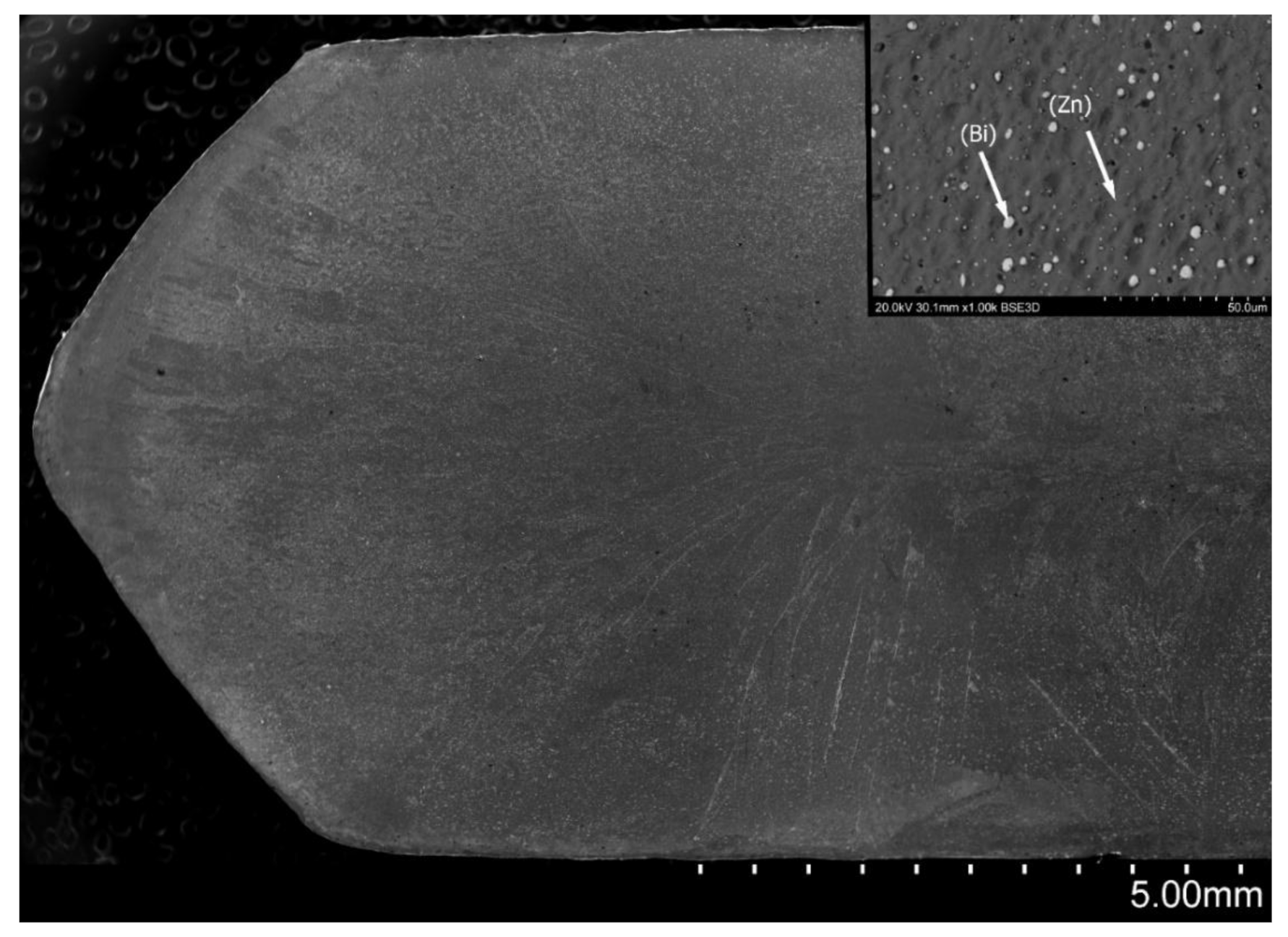
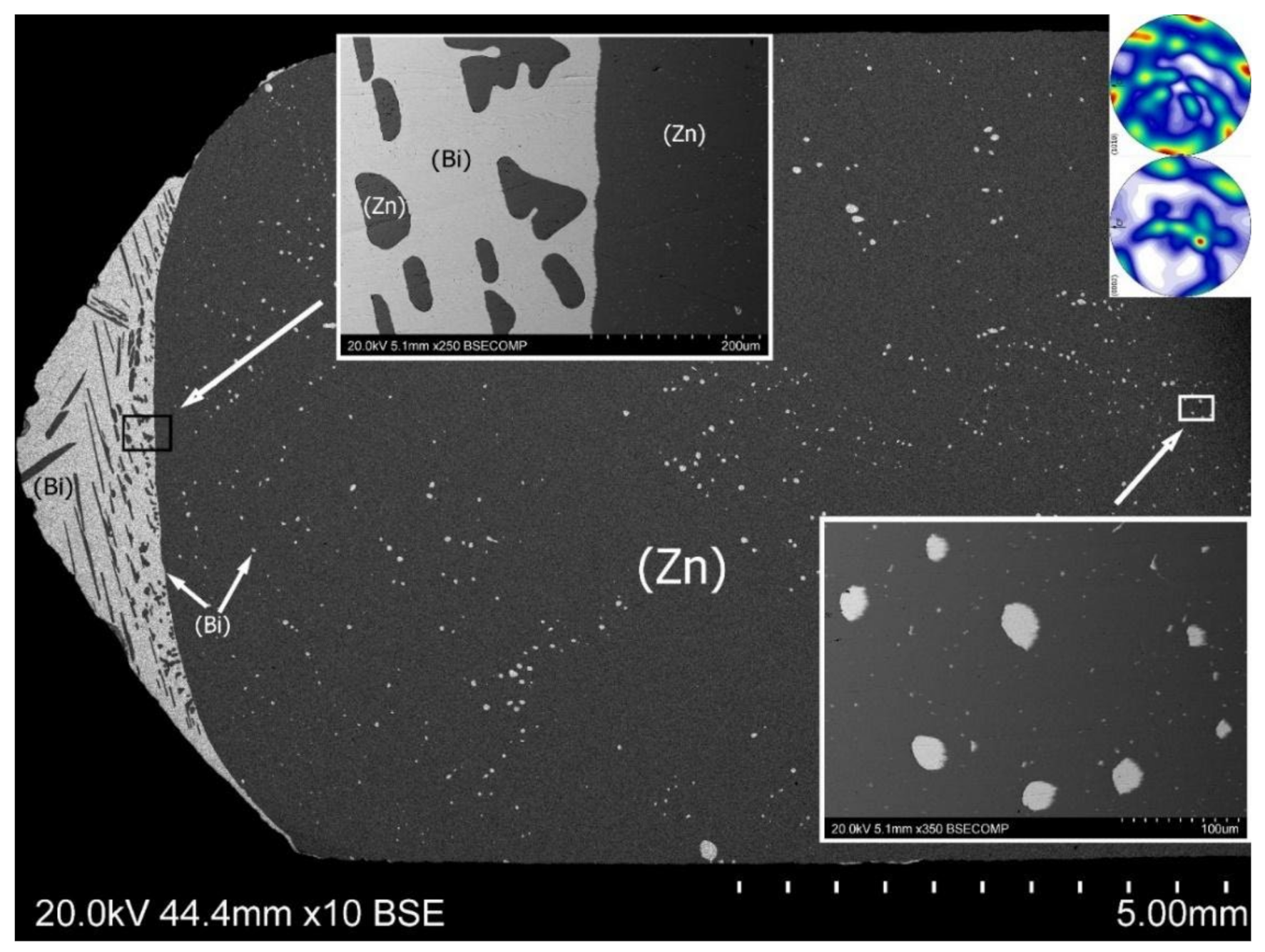
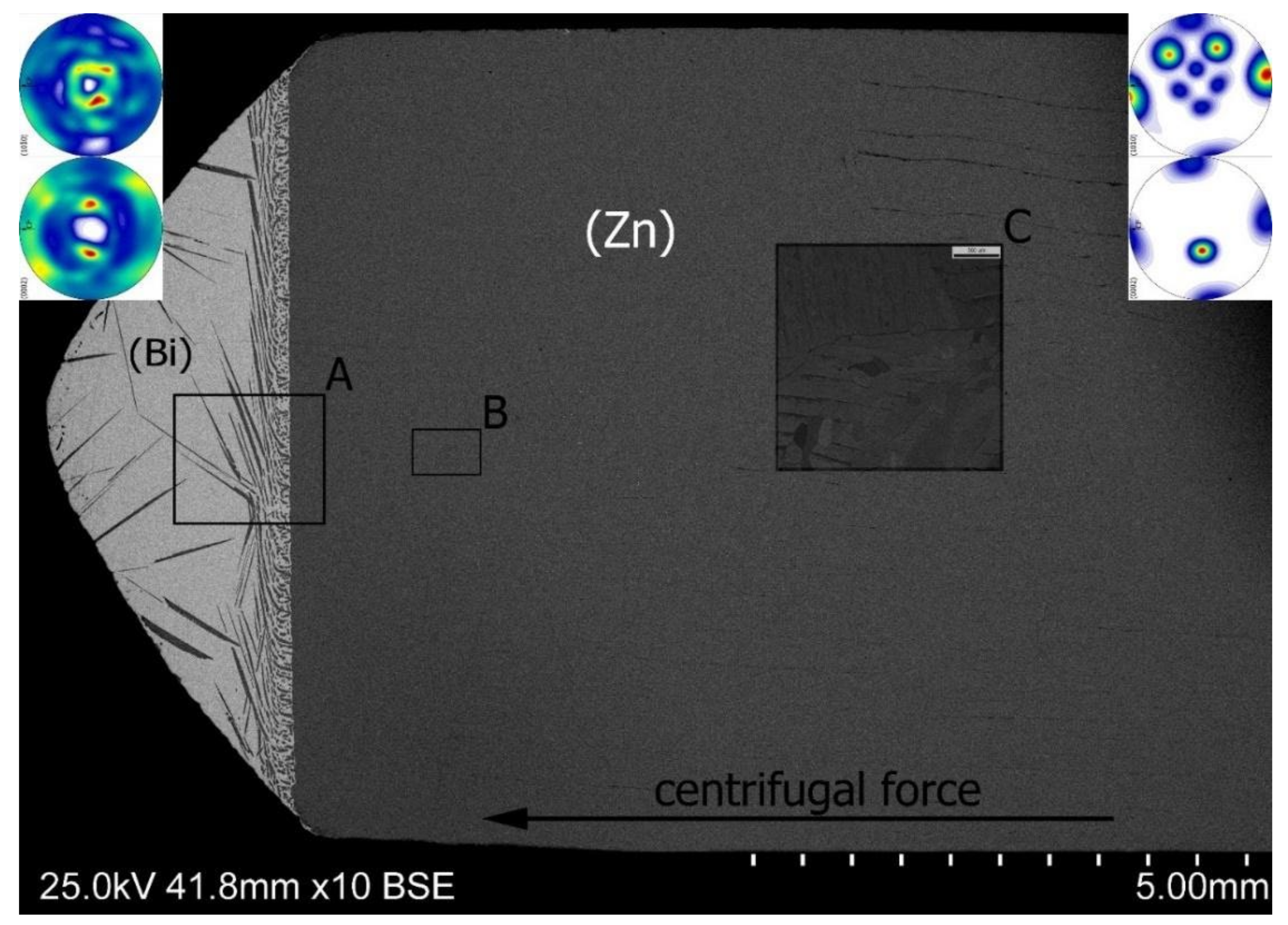


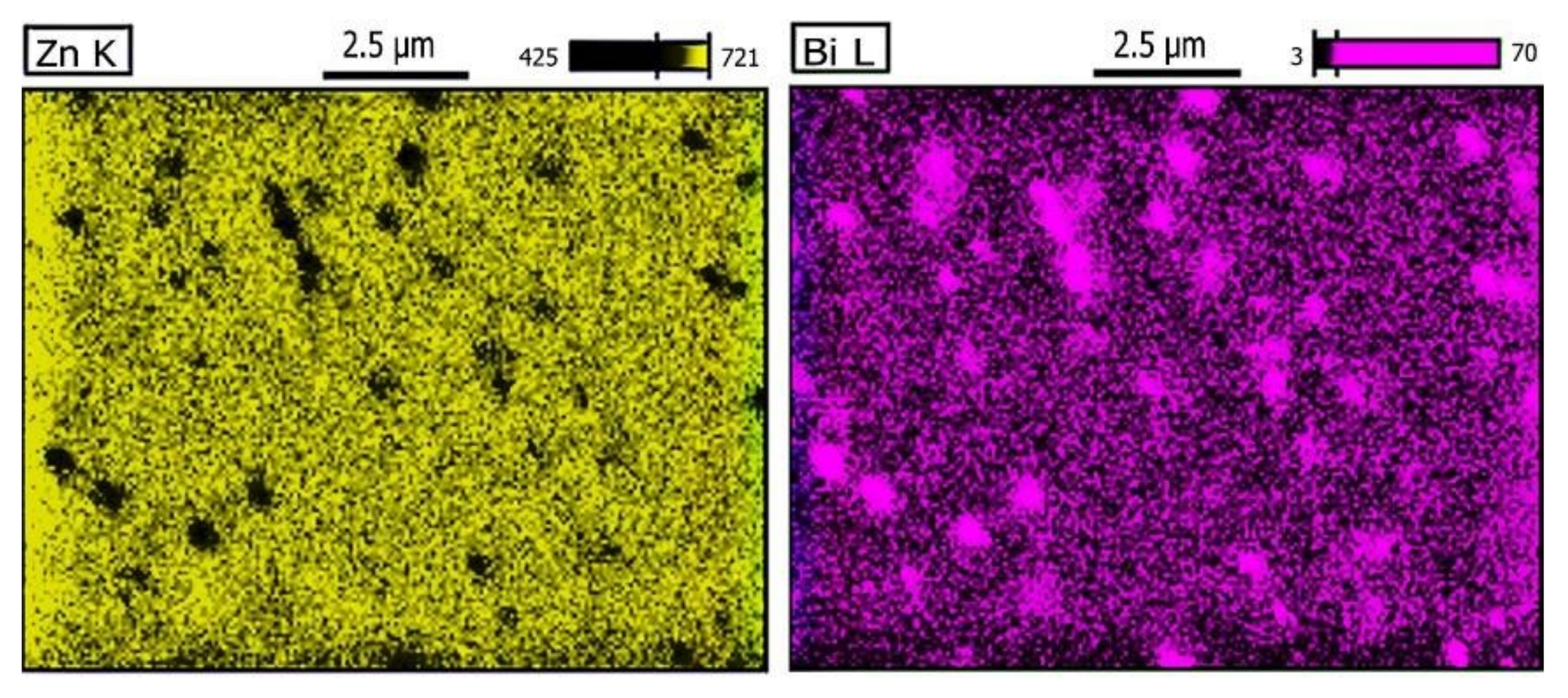
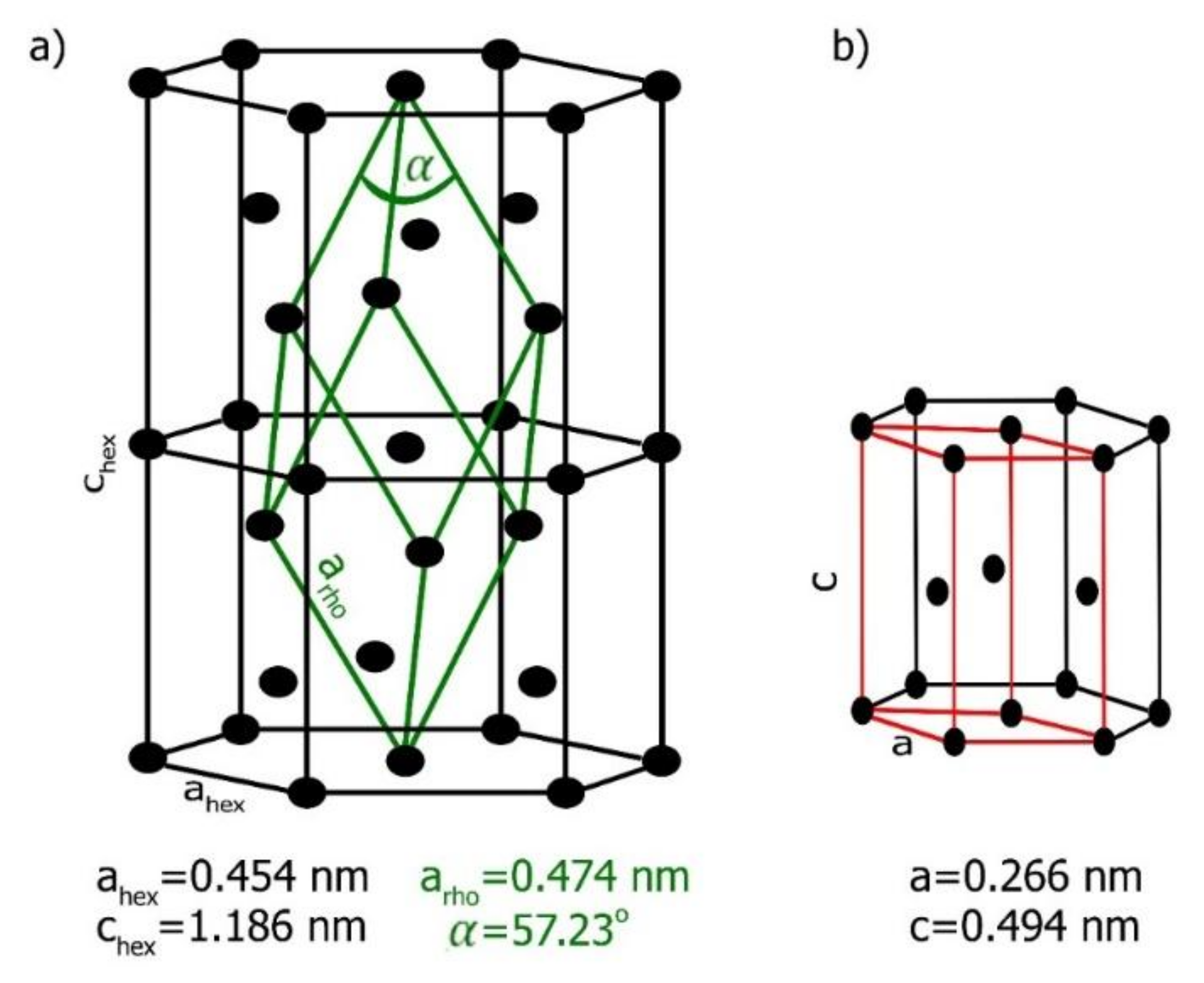





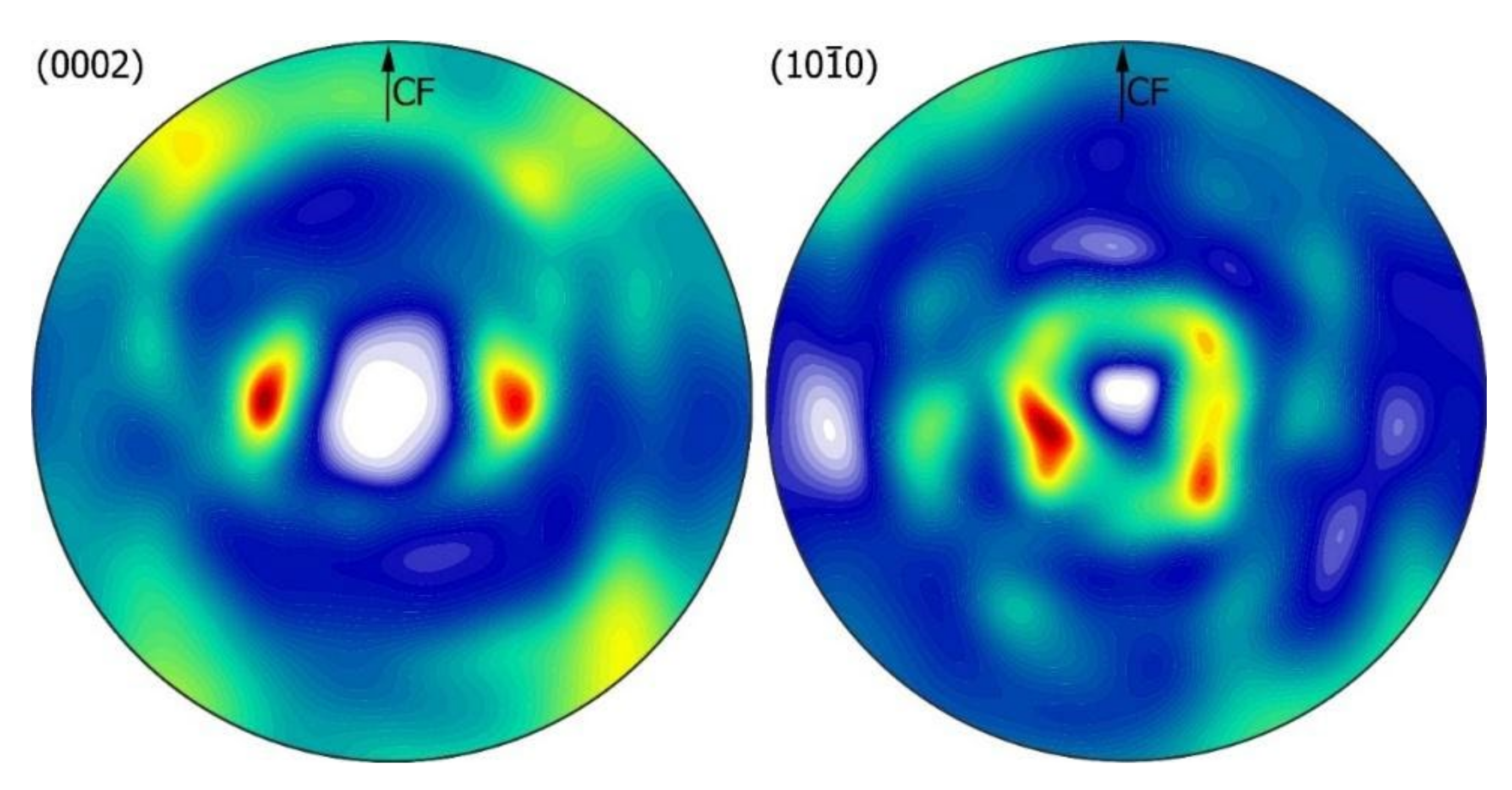
Publisher’s Note: MDPI stays neutral with regard to jurisdictional claims in published maps and institutional affiliations. |
© 2021 by the authors. Licensee MDPI, Basel, Switzerland. This article is an open access article distributed under the terms and conditions of the Creative Commons Attribution (CC BY) license (https://creativecommons.org/licenses/by/4.0/).
Share and Cite
Boczkal, G.; Palka, P.; Kokosz, P.; Boczkal, S.; Mrowka-Nowotnik, G. Non-Equilibrium Crystallization of Monotectic Zn-25%Bi Alloy under 600 g. Materials 2021, 14, 4341. https://doi.org/10.3390/ma14154341
Boczkal G, Palka P, Kokosz P, Boczkal S, Mrowka-Nowotnik G. Non-Equilibrium Crystallization of Monotectic Zn-25%Bi Alloy under 600 g. Materials. 2021; 14(15):4341. https://doi.org/10.3390/ma14154341
Chicago/Turabian StyleBoczkal, Grzegorz, Pawel Palka, Piotr Kokosz, Sonia Boczkal, and Grazyna Mrowka-Nowotnik. 2021. "Non-Equilibrium Crystallization of Monotectic Zn-25%Bi Alloy under 600 g" Materials 14, no. 15: 4341. https://doi.org/10.3390/ma14154341
APA StyleBoczkal, G., Palka, P., Kokosz, P., Boczkal, S., & Mrowka-Nowotnik, G. (2021). Non-Equilibrium Crystallization of Monotectic Zn-25%Bi Alloy under 600 g. Materials, 14(15), 4341. https://doi.org/10.3390/ma14154341






